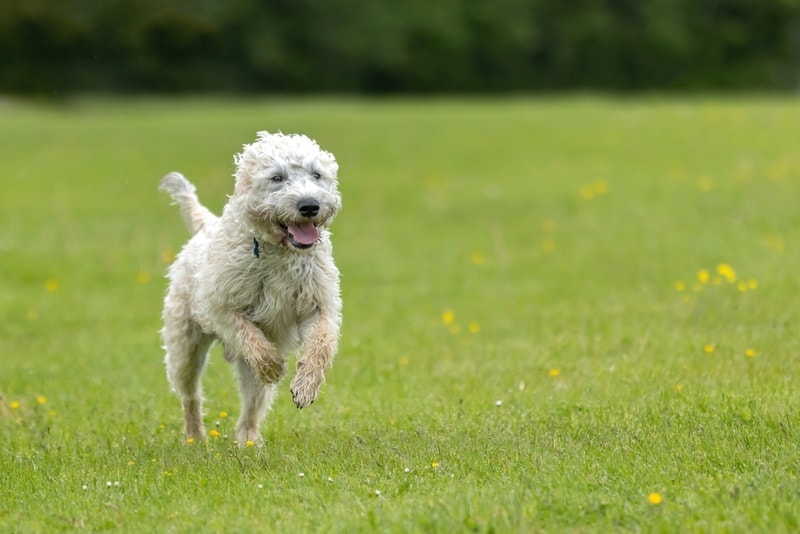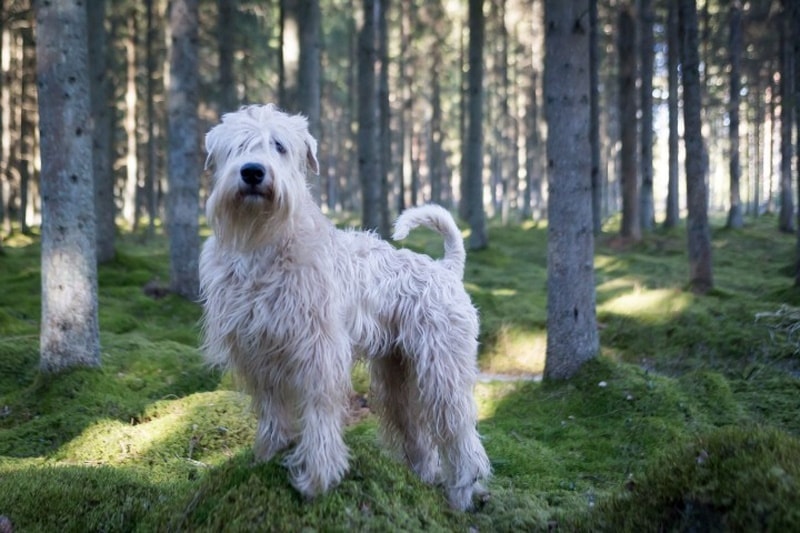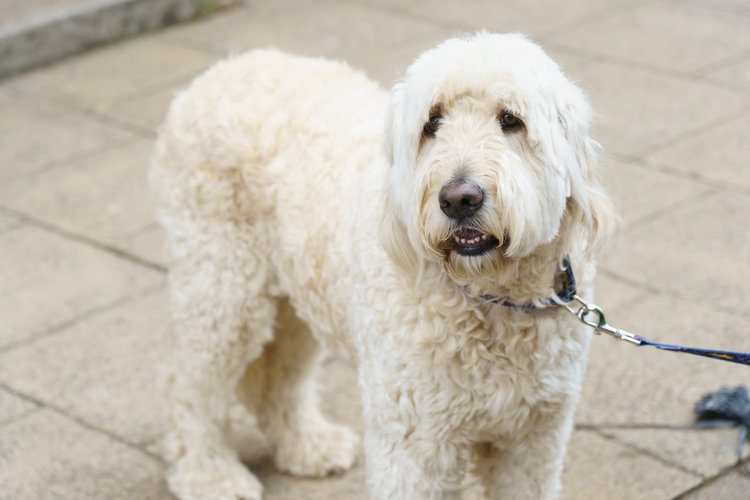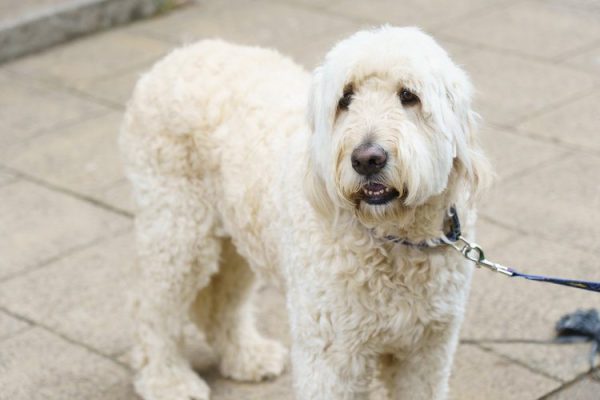Click to Skip Ahead
The white Labradoodle is a friendly crossbreed that has genes from the popular Labrador Retriever and the low-shedding Poodle. The result is a small to medium-sized dog with a curly coat and appealing temperament. The white Labradoodle itself is a color variation of Labradoodles, which can be found in colors such as black, brown, or even caramel.
White Labradoodles have a fascinating history that has led them to become popular canine companions.
Breed Overview
Height:
20 – 26 inches
Weight:
50 – 100 pounds
Lifespan:
12 – 15 years
Colors:
White
Suitable for:
Outgoing families with children and other compatible pets
Temperament:
Loyal, intelligent, active, friendly
All white Labradoodles have a white or chalky-colored coat with soft and slightly curled fur. Unlike their Poodle parents, white Labradoodles are not low-shedding or hypoallergenic dogs because they still shed quite a bit. Since most white Labradoodles have curly fur, some of their fur will get trapped in the curls which makes it appear as if these dogs aren’t shedding much.
You can also find white Labradoodles with wool or fleece-textured coats depending on which dogs they have been bred from. Many fond Labradoodle owners compare their Labradoodles’ coats to a teddy bear. White Labradoodles can vary in size depending, so if they have been bred with a toy Poodle and Labrador Retriever, they will be smaller than white Labradoodles bred from standard-sized Poodles.
White Labradoodle Breed Characteristics
The Earliest Records of Labradoodles in History
One of the earliest records of a Labradoodle in history dates back to the 1950s when Donald Campbell used the word Labradoodle to describe his dog which was a cross between a Poodle and a Labrador Retriever.
Labrador Retrievers have a history dating back to the 1830s when water dogs were bred with British hunting dogs. They were known for their excellent swimming skills back in the day, but now they are considered highly intelligent dogs that make excellent service dogs.
Poodles have a long history and were originally developed as water retrievers, game hunters, or as companion dogs in the Middle Ages. They are known for their low-shedding coats which makes them a popular choice for people looking for a dog that is less likely to set off any allergies they have. Poodles can be found in three different sizes—standard, miniature, or toy, which influences the size of the Labradoodle.
In the early 1960s, a Labradoodle named Fang was shown in a television show titled Get Smart and had a recurring role that brought some attention to this mixed dog breed.
How White Labradoodles Gained Popularity
It wasn’t until the 1980s that the Labradoodle would start to gain popularity and capture people’s attention. Due to the Labrador retriever’s high intelligence and trainability combined with the low-shedding miniature or standard Poodle, breeders aimed to develop a more hypoallergenic service dog.
This resulted in the Labradoodle, which shed slightly less than a Labrador Retriever thanks to the Poodles’ characteristics but also had the intelligence to be trained. The Australian breeder Wally Conron introduced the Labradoodle as a guide dog that was better suited for people with allergies. Years later, different color variations were starting to be produced, including a white version of the Labradoodle.

Formal Recognition of White Labradoodles
Since the white Labradoodle is a mixed breed, they are not formally recognized by the American Kennel Club (AKC) and there are no breed standards for this dog. However, both their parent breeds are recognized by the AKC. Even though the Labradoodle is not formally registered, several clubs and associations have been established to preserve this breed.
Top 3 Unique Facts About White Labradoodles
1. White Labradors Are Not Truly Hypoallergenic
While many people attribute hair as the main cause of their dog allergies, it is the dander and saliva found on the dog and their hair. While the Poodle is considered a low-shedding dog that is better suited for people with allergies, the Labrador Retriever genes don’t give the Labradoodle the same reputation. Labradoodles still shed but can be slightly better for people with allergies.
After all, this was the reason for the development of this mixed dog breed. The curly texture of the Labradoodle’s fur also plays a role in limiting the amount of hair that falls out.
2. The White Coat Is Inherited from the Poodle Parent
White is not considered a standard color for Labrador Retrievers, which means that the Labradoodle likely gets their white coat from their Poodle parent. However, achieving the look of a white Labradoodle may be accomplished by breeding lighter-colored Poodles and Labrador Retrievers. Even though many of the lighter colors Labrador Retrievers can be found in aren’t the breed standard, it is still possible.

3. There Are Different Generations of Labradoodles
You get different generations of Labradoodles, such as the F1, F1b, and the F2 gen. Labradoodles from the F1 gen are the direct offspring of a Poodle and Labrador Retriever, while the F2 gen Labradoodle is a cross between two F1 gen Labradoodles. Lastly, the F1b gen means that an F1 gen Labradoodle has been mixed with an unrelated Poodle. The type of generation that the Labradoodle is from can slightly influence their appearance and shedding level.
Do White Labradoodles Make a Good Pet?
Yes, white Labradoodles make good pets for families with children. They also make good guide dogs for people prone to mild allergies to dogs. Their intelligence makes them easy to train and follow commands, while the Poodle part of them gives them a soft and curly coat that makes them look like a teddy bear.
Labradoodles are not overly active dogs, but they still require a moderate amount of exercise like daily walks and some playtime. For grooming, the white Labradoodle can show dirt on their white fur more easily, making it appear discolored. Regular baths and grooming can ensure that your white Labradoodle’s appearance is maintained, while regular brushing prevents matting and removes loose hair.

Conclusion
The white Labradoodle was first referenced in the 1950s, but it wasn’t until the late 1980s that they started to gain popularity. Because they are a cross between two popular dog breeds, the White Labradoodle is not formally recognized and there is no breed standard for them. However, this doesn’t stop them from being amazing canine companions for people looking for an intelligent and playful mixed dog breed.
See also:
- What to Do if My Dog Ate Chocolate: 3 Vet-Approved Steps to Follow
- My Dog Ate Charcoal! What Do I Do? Vet-Approved Advice
Featured Image Credit: Steve Gill Photography, Shutterstock











